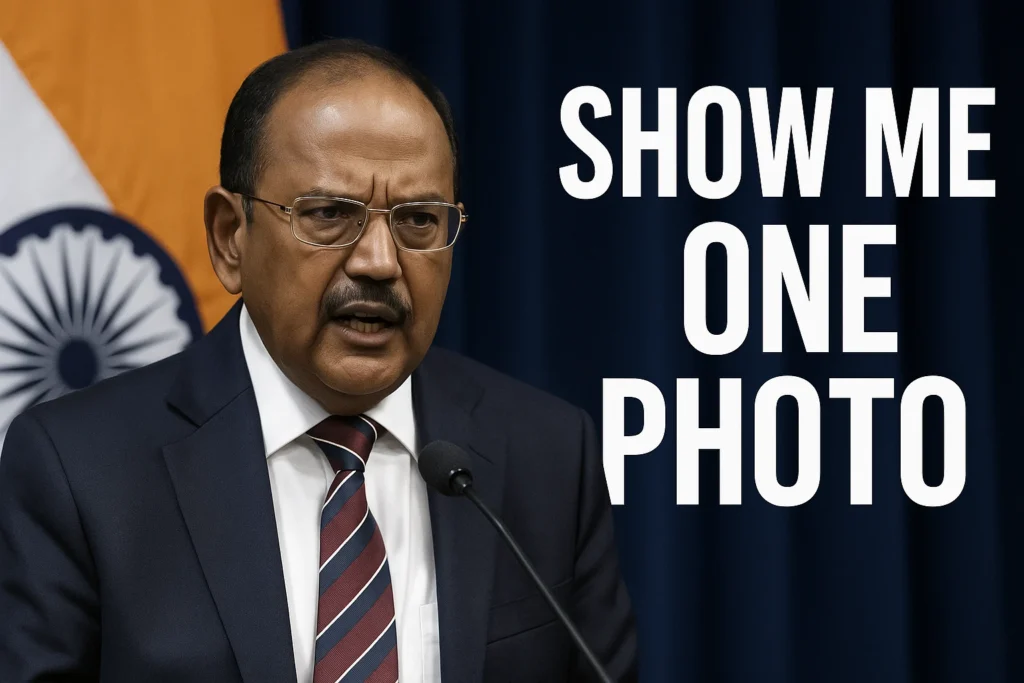Ajit Doval, India’s National Security Advisor, delivered a powerful rebuttal to Pakistan’s claims of inflicting damage during Operation Sindoor, asserting on July 11, 2025, that not a single photograph exists to prove any harm to Indian infrastructure. Speaking at the 62nd convocation of IIT Madras, Ajit Doval challenged foreign media and Pakistan to produce “even one image” of damage in India, emphasizing the precision of India’s military strikes on nine terrorist targets deep inside Pakistan. Launched on May 7, 2025, in response to the April 22 Pahalgam terror attack that killed 26 people, Operation Sindoor showcased India’s indigenous defense capabilities, including BrahMos missiles, and underscored a strategic triumph in a 23-minute operation. This blog post explores Ajit Doval’s remarks, the operation’s success, Pakistan’s counterclaims, and the broader implications for India’s national security, offering U.S. readers insight into a critical geopolitical event.

Table of Contents
The Context of Operation Sindoor
Ajit Doval’s remarks came in response to Pakistan’s narrative following Operation Sindoor, a military operation targeting nine terrorist camps in Pakistan and Pakistan-occupied Kashmir (PoK). The operation was India’s retaliatory strike after the Pahalgam attack, which killed 26 tourists and locals in Jammu and Kashmir. On May 7, 2025, Indian forces executed a 23-minute precision strike, neutralizing over 100 terrorists across locations like Bahawalpur (Jaish-e-Mohammed) and Muridke (Lashkar-e-Taiba). Ajit Doval highlighted the operation’s accuracy, stating, “We missed none. We hit nowhere else except that. The precision was to the point where we knew who was where”.
Pakistan, however, claimed it inflicted significant damage on Indian military bases, with its foreign ministry and media alleging strikes on 15 Indian locations. These claims, amplified by some foreign outlets like The New York Times, suggested Indian losses, including to Rafale jets. Ajit Doval dismissed these as “fabricated victories,” pointing out that satellite imagery showed damage to 13 Pakistani air bases, including Sargodha and Chaklala, while no evidence supported Pakistan’s assertions.
Doval’s Defiant Challenge
At IIT Madras, Ajit Doval took a firm stand against what he called a “calculated Pakistani disinformation campaign”. “You tell me one photograph, one imagery, which shows any Indian damage, even a glass pane having been broken,” he challenged, naming The New York Times for misleading coverage. He emphasized that Operation Sindoor was a testament to India’s technological prowess, driven by indigenous systems like BrahMos missiles and the Integrated Air Command and Control System. “We are proud of it, not necessarily for what people perceive… but that some of the best systems worked,” he said.
Doval’s remarks were not just a defense of the operation but a broader critique of international media bias. He pointed to satellite images showing damage to Pakistani air bases, contrasting them with the absence of any visual evidence of Indian losses. Posts on X echoed this sentiment, with users like @TimesAlgebraIND praising Doval’s challenge as a “wake-up call” to verify claims in an era of deepfakes. His speech resonated with audiences, earning loud cheers for highlighting India’s strategic and technological superiority.
The Precision of Operation Sindoor
Operation Sindoor, launched at 1:05 AM on May 7, 2025, was a masterclass in military precision. Ajit Doval revealed that India targeted nine high-value terrorist hubs deep inside Pakistan, far from border areas, in a “criss-cross pattern” to maximize impact. The operation, completed in just 23 minutes, used 15 BrahMos missiles to disrupt Pakistan’s ability to launch aircraft, with strikes on air bases like Rahim Yar Khan and Sargodha. Doval emphasized zero collateral damage on the Indian side, a claim backed by satellite imagery showing no damage to Indian infrastructure.
The operation’s success was rooted in India’s indigenous technology. Ajit Doval lauded systems like the BrahMos missile and GUARD-X technology, which ensured pinpoint accuracy. A former U.S. Air Force pilot reportedly assessed the role of India’s Rafale jets, dismissing Pakistan’s claims of destroying them as recycled footage from a 2024 MiG-29 crash. This technological edge, combined with precise intelligence, allowed India to neutralize threats without escalating into full-scale conflict.
Pakistan’s Response and Escalation
Pakistan’s reaction to Operation Sindoor was swift but inconsistent. On May 7, Pakistan rejected India’s request for dialogue, with its DGMO warning of a “severe response”. Heavy artillery fire along the Line of Control followed, prompting India to strike additional Pakistani military assets. By May 10, both nations agreed to cease hostilities, with Pakistan proposing a truce. Pakistan’s foreign ministry, led by Ishaq Dar, later dismissed Ajit Doval’s claims of “zero damage” as a “distortion,” calling for de-escalation but offering no evidence to counter India’s narrative.
Posts on X reflected Pakistan’s frustration, with some users amplifying unverified claims of Indian losses, while others, like @Warlock_Shubh, celebrated India’s targeted strikes. Pakistan’s reliance on recycled imagery, such as a fake “Srinagar Airbase strike” video, was exposed as propaganda, further weakening its position.
Implications for India’s Security Strategy
Ajit Doval’s speech underscored a broader shift in India’s national security approach: prioritizing indigenous technology and narrative control. He linked Operation Sindoor to past incidents, like the 2020 Chinese incursions in Ladakh, to stress the need for self-reliance in defense. “We have to develop our indigenous technology,” he urged, citing the operation’s success as a case study in modern warfare. This focus aligns with India’s push to indigenize communication infrastructure, protecting sensitive data from external threats.
For U.S. observers, Operation Sindoor highlights India’s growing military and technological capabilities, a key factor in Indo-U.S. strategic partnerships. Ajit Doval’s briefing to U.S., UK, and other counterparts post-operation signaled India’s intent to maintain global alliances while asserting its regional dominance. The operation also serves as a warning to adversaries about India’s ability to execute precise, limited strikes without triggering broader conflict.
Global Media and the Narrative War
Ajit Doval’s challenge to foreign media, particularly outlets like The New York Times and New York Post, highlighted the role of information warfare in modern conflicts. He accused them of bias, noting that satellite images showed damage to Pakistani air bases but none in India. This narrative battle, as Doval described, is as critical as territorial victories, especially in an era of deepfakes and misinformation. His call for evidence resonated with X users, who praised his “no-nonsense” approach to countering false narratives.
The operation’s media coverage also revealed challenges for U.S. and global audiences in discerning fact from propaganda. Doval’s emphasis on verifiable evidence, like satellite imagery, aligns with calls for journalistic rigor in conflict reporting, a lesson relevant to U.S. media covering international disputes.
What’s Next?
Ajit Doval’s remarks have reframed Operation Sindoor as a triumph of precision and technology, bolstering India’s image as a formidable regional power. For Pakistan, the lack of evidence to support its claims weakens its position, while India’s strategic restraint—ceasing hostilities on May 10—demonstrates a commitment to de-escalation. As India invests in indigenous defense systems, future operations may further leverage technology to counter threats, with implications for global security dynamics.
For U.S. readers, Ajit Doval’s leadership and Operation Sindoor underscore India’s role as a stabilizing force in South Asia, with lessons for counterterrorism and technological self-reliance. The operation’s success, driven by precision and indigenous systems, positions India as a key player in global defense conversations.
Frequently Asked Questions :
1. What did Ajit Doval say about Pakistan’s claims during Operation Sindoor?
Ajit Doval challenged Pakistan and foreign media to provide “one photograph” of damage to Indian infrastructure, asserting no evidence exists, even of a “broken glass pane”.
2. What was Operation Sindoor?
Launched on May 7, 2025, Operation Sindoor was India’s 23-minute precision strike on nine terrorist camps in Pakistan, targeting groups like Jaish-e-Mohammed in response to the Pahalgam attack.
3. How did Pakistan respond to Operation Sindoor?
Pakistan claimed it hit 15 Indian locations but offered no evidence. It rejected dialogue initially but agreed to a truce on May 10, 2025.
4. What technology did India use in Operation Sindoor?
India deployed indigenous systems like BrahMos missiles, GUARD-X technology, and the Integrated Air Command and Control System, ensuring precise strikes.
5. Why is Ajit Doval’s speech significant for U.S. audiences?
Doval’s emphasis on precision, indigenous technology, and countering misinformation highlights India’s growing defense capabilities and its role in global security, relevant to U.S. strategic interests.
- Amazon India Unleashes Thrilling 72-Hour Prime Day 2025 Sale: Up to 65% Off Laptops, ACs, TVs, and
- Dhadak 2 Delay: 16 Shocking Cuts Spark Karan Johar’s Bold Response to CBFC
- Sinner vs Djokovic: 5 Heartbreaking Moments from Novak’s Wimbledon Confession After Sinner’s Classy Act
- Jersey’s Stunning Victory Over Scotland in T20 Scotland vs Jersey World Cup Qualifier Ends in Heartbreak
- Air India Plane Crash Report Unveils Shocking Pilot Confusion in Fatal Disaster 2025


1 thought on “Ajit Doval’s Bold Defense: 9 Precision Strikes in Operation Sindoor Prove India’s Might, No Damage at Home”